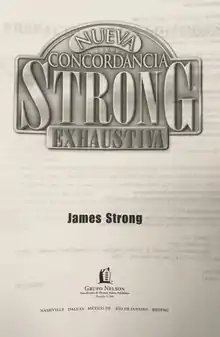Strong's Concordance
The Exhaustive Concordance of the Bible,[n 1] generally known as Strong's Concordance, is a Bible concordance, an index of every word in the King James Version (KJV), constructed under the direction of James Strong. Strong first published his Concordance in 1890, while professor of exegetical theology at Drew Theological Seminary.



Purpose
The purpose of Strong's Concordance is not to provide content or commentary about the Bible, but to provide an index to the Bible. This allows the reader to find words where they appear in the Bible. This index allows a student of the Bible to re-find a phrase or passage previously studied. It also lets the reader directly compare how the same word may be used elsewhere in the Bible.
Strong's numbers
Each original-language word is given an entry number in the dictionary of those original language words listed in the back of the concordance. These have become known as the "Strong's numbers". The main concordance lists each word that appears in the KJV Bible in alphabetical order with each verse in which it appears listed in order of its appearance in the Bible, with a snippet of the surrounding text (including the word in italics). Appearing to the right of the scripture reference is the Strong's number. This allows the user of the concordance to look up the meaning of the original language word in the associated dictionary in the back, thereby showing how the original language word was translated into the English word in the KJV Bible.
Strong's Concordance includes:
- The 8,674 Hebrew root words used in the Old Testament. (Example: אֱנוֹשׁ (H582))
- The 5,624 Greek root words used in the New Testament. (Example: λόγος (G3056))
New editions of Strong's may exclude the comparative section (1611 KJV to 1614) and the asterisks that denote differential definitions of the same Hebrew or Greek words; due perhaps to denominational considerations, definitions may also be altered.
Although the Greek words in Strong's Concordance are numbered 1–5624, the numbers 2717 and 3203–3302 are unassigned due to "changes in the enumeration while in progress". Not every distinct word is assigned a number, but rather only the root words. For example, αγαπησεις is assigned the same number as αγαπατε – both are listed as Greek word #25 in Strong's Concordance (αγαπαω).
Other authors have used Strong's numbers in concordances of other Bible translations, such as the New International Version and American Standard Version.
Due to Strong's numbers it became possible to translate concordances from one language into another. Thus, the Russian concordance of 30,000 words from the Russian Thompson Study Bible ("Новая учебная Библия Томпсона", La Buona Novella Inc, 2010, edition made by the Christian society "The Bible for everyone" in St.Petersburg, Russia) is a translation of the English concordance from Thompson Chain-Reference Bible (The New Thompson Study Bible, La Buona Novella Inc. & B.B. Kirkbride Bible Company, Inc., 2006). In the process of compiling the Russian concordance, the Hebrew/Greek word corresponding to the English concordance word was found, and then its Russian equivalent in the Russian Synodal translation of the Bible was added to the resulting Russian concordance text.
New editions of Strong's Exhaustive Concordance of the Bible remain in print as of 2016.
Strong's Dictionaries
In the 1890 version, Strong added a "Hebrew and Chaldee Dictionary" and a "Greek Dictionary of the New Testament" to his concordance. In the preface to both dictionaries, Strong explains that these are "brief and simple" dictionaries, not meant to replace reference to "a more copious and elaborate Lexicon." He mentions Gesenius and Fürst as examples of the lexicons that Strong's is drawn from. His dictionaries were meant to give students a quick and simple way to look up words and have a general idea of their meaning.
Strong reportedly based his lexicons on the work of contemporary scholars such as Gesenius, Fürst, Liddell & Scott, Thayer, and Brown, Driver, and Briggs. According to the preface, he and his team also made "numerous original suggestions, relations, and distinctions... especially in the affinities of roots and the classification of meanings." The work is intended to represent the best of 19th century scholarship, and both a simplification of it and an improvement on it. An important feature of Strong's dictionaries is the listing of every translation of a source word in the AV (King James) after the definition itself.
It is important to note Strong's association with the committee working on the American Revised Version of the Bible. His work does not tend to support the authority of the King James Version. He was part of the effort to update and replace it with what the translators believed would be a better version. As a result, he contributed deeper and more thorough study of Biblical languages, especially etymology, but also an inherently suspicious attitude toward the Textus Receptus, the King James, and toward traditional, less "secular" definitions of original words. The translation committee was associated with the higher critical movement and with the Westcott-Hort version of the Greek text. Strong, a Methodist layman and college professor, was acceptable to the committee, but one cannot assume he shared all of its views.[2]
See also
Notes
- The complete title of the original work was The Exhaustive Concordance of the Bible: Showing Every Word of the Text of the Common English Version of the Canonical Books, and Every Occurrence of Each Word in Regular Order: Together with A Comparative Concordance of the Authorized and Revised Versions, Including the American Variations; Also Brief Dictionaries of the Hebrew and Greek Words of the Original, with References to the English Words.[1]
References
- Strong (1890), p. 1.
- , This is a hostile source but it cites original sources.
Bibliography
- Strong, James (1890), The Exhaustive Concordance of the Bible, Cincinnati: Jennings & Graham.
External links
- Preface to Strong's Concordance
- Old and New Testaments with every word linked to Strong's Concordance
- Look up Hebrew words in Strong's Concordance
- Look up Greek words in Strong's Concordance
- Several English versions of OT and NT with Greek and Hebrew words linked to Strong's Concordance
- Strong's Concordance Online Searchable
- Strong's Concordance online
- Look up words in Strong's Concordance
- Look up Greek words in Strong's Greek Dictionary
- Download Strong's Greek Dictionary in XML form
- Strong's Concordance Database(xls)
- Look up Greek Septuagint words in AB-Strong's Concordances